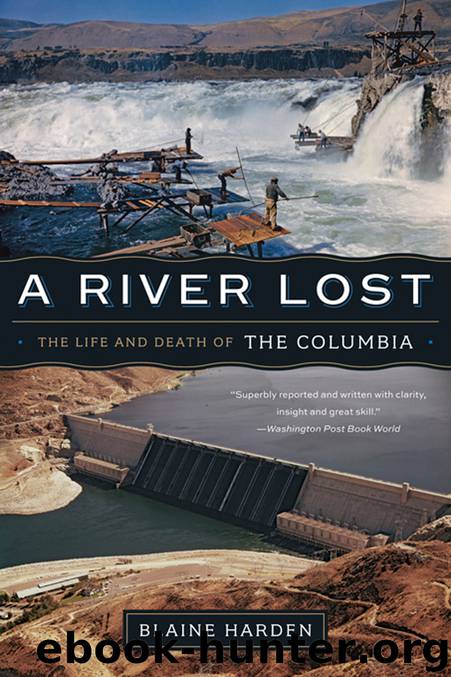A River Lost by Blaine Harden

Author:Blaine Harden
Language: eng
Format: epub
Publisher: W. W. Norton & Company
Published: 2012-03-06T16:00:00+00:00
The character of this aberrant Eden was neatly packaged when a hell-raiser by the name of Norm Buske paddled a rubber boat along the Hanford Reach. Buske positioned himself just downstream from N Reactor, a giant decommissioned nuclear plant that for twenty years had pumped about a billion gallons of radioactive waste into two open trenches, one of which lies less than the length of a football field from the Columbia. An underground spring, affectionately called N Springs by plant workers, ran beneath the two trenches and dribbled into the river. Among the many unappetizing pollutants that were measurable in N Springs was strontium-90, a highly carcinogenic radionuclide with a half-life of three hundred years and a penchant for seeking out and lodging in human bone. The concentration of strontium-90 in N Springs was, at the time of Buske’s rubber-boat adventure, about nine hundred times higher than the federal standard for safe drinking water.
In the rubber boat that day, Buske, by training a physicist and by avocation an anti-nuclear troublemaker, knew where N Springs was and what it contained. What he had not expected to find, on the shoreline and washed in the nightshade seepage of N Springs, was a crop of perfectly ripe mulberries. Inspired by their juicy pulchritude, he paddled up to the west bank of the river, picked a quart of berries without getting out of his boat (which would have been a violation of federal law), and rushed home to make jam. He mailed his jam, along with a letter, to the governor of the state of Washington and to the secretary of energy. The letter said: “This mulberry jam is a token of the future hazard of unidentified, uncontained, and unmanaged radioactivity at Hanford.”
So it was that two jars of ruby-red preserves triggered the mulberry syndrome.
Alarmed consumers swamped the Washington State Department of Health with questions about the safety of the state’s celebrated apples and peaches. Agribusiness got angry. Politicians demanded action. The mulberries, in fact, were a very low-level risk. Buske told me he would have had to eat an entire jar of mulberry jam every day for a year before he would begin to worry about his health. But in the politics of nuclear fear, where paranoia is a given and distrust of the government runs deep, a nicely turned media perception usually outweighs scientific risk. Hanford workers, therefore, were ordered down to the river. Wearing blazing white radiation suits and armed with chainsaws, they mowed down every mulberry bush in sight, stuffing severed limbs and mashed berries into concrete coffins.
After three years of policy-option papers and mid-level bureaucratic waffling, the mulberry coffins were sent out on the road. They were trucked to Oak Ridge, Tennessee, to the nation’s only certified incinerator for low-level radioactive waste. There, the bushes and berries were mashed, analyzed, cremated, placed in an urn, and shipped back to Hanford for burial in a special pit designed for low-level waste.
The price tag for the hysteria that Buske so shrewdly
Download
This site does not store any files on its server. We only index and link to content provided by other sites. Please contact the content providers to delete copyright contents if any and email us, we'll remove relevant links or contents immediately.
The Lonely City by Olivia Laing(4113)
Animal Frequency by Melissa Alvarez(3750)
All Creatures Great and Small by James Herriot(3508)
Walking by Henry David Thoreau(3228)
Exit West by Mohsin Hamid(3173)
Origin Story: A Big History of Everything by David Christian(3133)
COSMOS by Carl Sagan(2944)
How to Read Water: Clues and Patterns from Puddles to the Sea (Natural Navigation) by Tristan Gooley(2849)
Hedgerow by John Wright(2772)
The Inner Life of Animals by Peter Wohlleben(2763)
Origin Story by David Christian(2677)
How to Read Nature by Tristan Gooley(2657)
Project Animal Farm: An Accidental Journey into the Secret World of Farming and the Truth About Our Food by Sonia Faruqi(2656)
How to Do Nothing by Jenny Odell(2640)
A Forest Journey by John Perlin(2584)
Water by Ian Miller(2579)
The Plant Messiah by Carlos Magdalena(2451)
A Wilder Time by William E. Glassley(2358)
Forests: A Very Short Introduction by Jaboury Ghazoul(2331)
